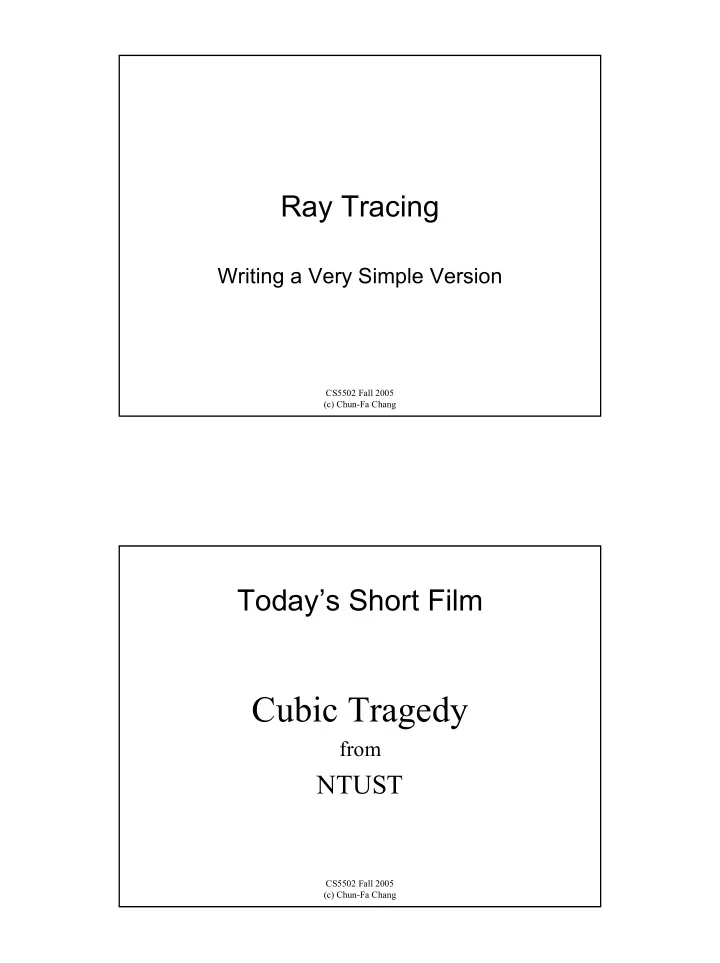

Ray Tracing Writing a Very Simple Version CS5502 Fall 2005 (c) Chun-Fa Chang Today’s Short Film Cubic Tragedy from NTUST CS5502 Fall 2005 (c) Chun-Fa Chang
What Makes a Good Picture? • Contents (3D models). • Lighting. • Reflection. • Shadow. • Surface textures. CS5502 Fall 2005 (c) Chun-Fa Chang Ray Tracing Algorithm • An overview in Pharr’s 1.2 • More detail in Watt’s 10.3.1 (pp.284-286) and 12.2-12.4 (pp.342-354) Transmitted Reflected CS5502 Fall 2005 (c) Chun-Fa Chang
Creating a Ray • Parameters: – Image Plane (position, size, and resolution) – Viewpoint – Which ray (x, y)? CS5502 Fall 2005 (c) Chun-Fa Chang Ray-Object Intersection • For example: sphere (x-x 0 ) 2 +(y-y 0 ) 2 +(z-z 0 ) 2 =r 2 • Ray: (x,y,z)=(x 1 ,y 1 ,z 1 )+t(x d ,y d ,z d ) • Find t that satisfy (x-x 0 ) 2 +(y-y 0 ) 2 +(z-z 0 ) 2 =r 2 • Normal vector? • Also easy for planes, cones, …etc. CS5502 Fall 2005 (c) Chun-Fa Chang
Shading Models • Pixel color = ambient + diffuse + specular + reflected + transmitted • The weight of each is determined by the surface properties. • We will discuss each of them within the next a few lectures. CS5502 Fall 2005 (c) Chun-Fa Chang Light Source & Shadow • Point light is easy to implement, but does not look real. • How to determine a surface point is in the shadow? • In real world: area light with soft shadow. CS5502 Fall 2005 (c) Chun-Fa Chang
Reflection and Refraction • Reflected ray is determined by: – incoming ray and normal vector. • Refracted ray is determined by: – Incoming ray – Normal vector – And density θ i θ t • Snell’s law: • η I sin θ i = η t sin θ t CS5502 Fall 2005 (c) Chun-Fa Chang Recursive Algorithm • The reflected ray and refracted ray are traced recursively. • Termination condition: – Depth of trace – Weight (to the final pixel color) of ray CS5502 Fall 2005 (c) Chun-Fa Chang
Advantage • We get all the following automatically: – Hidden surface removal – Shadow – Reflection – Transparency and refraction CS5502 Fall 2005 (c) Chun-Fa Chang Disadvantage • Slow. Many rays are spawned. • Slow. Ray-object intersection for every ray and every object. (We will discuss how to avoid this in the next lecture). • The lighting is still not completely right! CS5502 Fall 2005 (c) Chun-Fa Chang
Assignment 1 – A Ray Tracer • Split into two parts. • Part A due October 3. – Camera module – Object module (sphere only) – No recursive ray tracing – Simple output (in text mode) • The rest (Part B) are due October 17. CS5502 Fall 2005 (c) Chun-Fa Chang Required Modules • Camera Module • Object Module • Ray Tracer Module (main program) • Display (Output) Module CS5502 Fall 2005 (c) Chun-Fa Chang
Camera Module • Definition of eye position and image plane. • Generating a ray if given (x, y) – Note that x and y may be real numbers (not integers). CS5502 Fall 2005 (c) Chun-Fa Chang Object Module • Sphere type only (for now). • Ray-object intersection. • Light. • Read from files. • Camera is sometimes defined in the object file for convenience. CS5502 Fall 2005 (c) Chun-Fa Chang
Ray Tracer Module • Integration of other modules. • Shading. • Spawn reflected and refracted rays. CS5502 Fall 2005 (c) Chun-Fa Chang Display (Output) Module • Output to a text file for now. • Example: output 0 if no intersection and 1 if intersecting an object. • May create PPM, TIFF, or JPEG files later. CS5502 Fall 2005 (c) Chun-Fa Chang
Part A due October 3 • Camera module • Object module – Read from a file – Sphere and Light only • Ray tracer module: – No shading. No reflection and refraction. • Display module (in text mode) CS5502 Fall 2005 (c) Chun-Fa Chang Part B due October 17 • Object module – Add at least a plane type. • Ray tracer module: – Add shading, reflection, and refraction. • Display module: – PPM, TIFF, or JPEG library will be provided. • Add a demo scene of your own. CS5502 Fall 2005 (c) Chun-Fa Chang
Recommend
More recommend